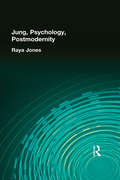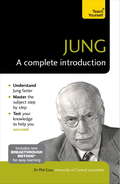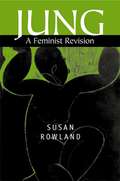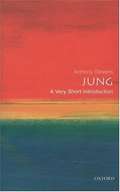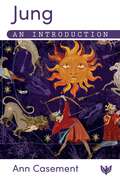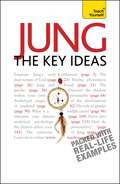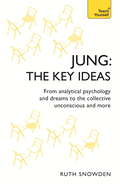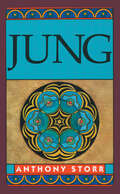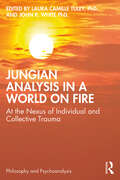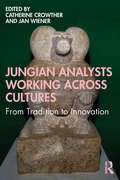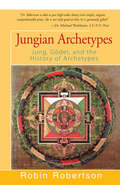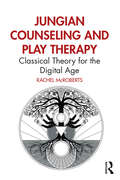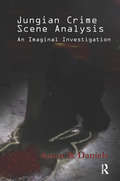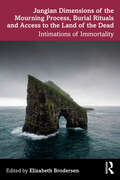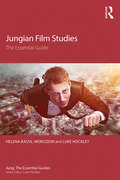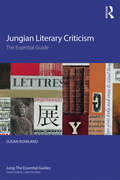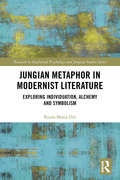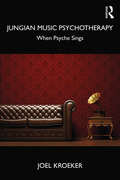- Table View
- List View
Jung, Psychology, Postmodernity
by Raya JonesJung, Psychology, Postmodernity explores points of confluence and, more often, contradictions between Jungian and postmodern ideas. Throughout the book Raya Jones examines how personal meaning emerges in human activity. Jung addressed this in terms of symbol formation, with particular attention to dreams, myths, art and other fantasy productions. Postmodern psychologists tend to address issues of meaning in terms of peoples self-understanding and identity construction, with a focus on self-positioning in actual conversation or on autobiographical narratives. Jones draws a line of critical comparison between postmodern psychology and Jung’s descriptions of the symbolic dimension, myth, and the structure of the psyche. The book culminates with an evaluation of Jung’s psychic energy concept, for which there is no direct counterpart in postmodern psychology. Jung, Psychology, Postmodernity is an original critique of two key moments in the history of psychology. It will be welcomed by Jungians, as well as psychotherapists, and students of psychology.
Jung: A Complete Introduction: Teach Yourself
by Phil GossJung: A Complete Introduction is designed to give you everything you need to succeed, all in one place. It covers the key areas that students are expected to be confident in, outlining the basics in clear, jargon-free English and providing added-value features like summaries of key books, and even lists of questions you might be asked in your seminar or exam.The book uses a structure that mirrors the way Jung is taught on many university and counselling courses. Chapters include individuation and the archetypal power of the unconscious, Jung's early life, Jung's early career and key influences, Freud and Jung, the self and ego, the dark side, anima and animus, archetypes, typology, Jungian analysis, working with dreams, active imagination, developmental approaches, application of Jungian analysis to mental health needs, and Jung's legacy in culture, spirituality and therapy.Jung employs the 'Breakthrough Method' to help you advance quickly at any subject, whether you're studying for an exam or just for your own interest. The Breakthrough Method is designed to overcome typical problems you'll face as learn new concepts and skills.- Problem: "I find it difficult to remember what I've read."; Solution: this book includes end-of-chapter summaries and questions to test your understanding.- Problem: "Lots of introductory books turn out to cover totally different topics than my course."; Solution: this book is written by a university lecturer who understands what students are expected to know.
Jung: A Feminist Revision
by Susan RowlandThis book is designed for the new reader of Jung, for all those engaged with feminism and for researchers. Two chapters sketch the man, his life with women, and then carefully introduce all his important ideas. C. G. Jung loved the feminine all his life. The feminine is the pivotal fulcrum of both his work and his psyche. Yet Jung was certainly not a feminist in the sense of promoting women's participation in the world. This book not only introduces Jung to those who have never before encountered his ideas; it applies the full range of feminist research to remedy the neglect.
Jung: A Very Short Introduction
by Anthony StevensThis is the most lucid and timely introduction to the thought of Carl Gustav Jung available to date. Though he was a prolific writer and an original thinker of vast erudition, Jung lacked a gift for clear exposition, and his ideas are less widely appreciated than they deserve to be. Now, in this extremely accessible introduction, Anthony Stevens--one of Britain's foremost Jungian analysts--clearly explains the basic concepts of Jungian psychology: the collective unconscious, complex, archetype, shadow, persona, anima, animus, and the individualization of the Self. A small masterpiece of insight and concision, this volume offers a clear portrait of one of the twentieth century's most important and controversial thinkers.
Jung: An Introduction
by Ann CasementThis book is an introduction to the ideas of the Swiss psychologist and psychoanalyst, C. G. Jung. The first chapter describes his early home life whilst subsequent chapters are devoted to his work in various sectors. This started in psychiatry at Burgholzli Hospital in Zurich, where Eugen Bleuler was the Director, a significant figure in Jung's life for many years. The book goes on to describe at some length the professional relationship between Freud and Jung, and the disastrous impact of their subsequent acrimonious split in 1913 on themselves but, more importantly, on the profession of psychoanalysis itself, both at that time and subsequently. Several chapters elaborate Jung's main concepts, including an extensive investigation of his all-important work on psychological alchemy, which includes 10 black and white illustrations from the alchemical text The Rosarium Philosophorum and 10 black and white ox-herding pictures of Kuo-an from the twelfth-century Buddhist tradition. The rest of the book depicts some of the significant women and men who contributed to analytical psychology, which is the term Jung chose to designate his psychoanalytic discipline. This is used interchangeably with the term psychoanalysis as many Jungians designate themselves psychoanalysts, including the author, as a New York State licensed psychoanalyst. This is also an account of some of the scientific, philosophical, and psychological influences on Jung's thinking. The book concludes with an entry on China, where the author has spent the last few years analysing, lecturing, supervising, and teaching analytical psychology to Chinese psychotherapists, counsellors, and students in Beijing and Shanghai. This comprehensive work is essential reading for all those with an interest in C. G. Jung and his work.
Jung: Bullet Guides
by Robert AndersonOpen this book and you will Understand analytical psychology Explore Jungian thought Grasp essential concepts Explore the psyche
Jung: Bullet Guides
by Robert AndersonOpen this book and you will Understand analytical psychology Explore Jungian thought Grasp essential concepts Explore the psyche
Jung: From analytical psychology and dreams to the collective unconscious and more (TY Philosophy)
by Ruth SnowdenJung - the Key Ideas will quickly familiarize you with the revolutionary thinking of this great man. It will teach you all the essential concepts, from the collective unconscious to archetypes in dreams. Expressing Jung's sometimes complex ideas in simple terms, and backed up with references to his own texts, this book gives you everything you need to know.NOT GOT MUCH TIME?One, five and ten-minute introductions to key principles to get you started.AUTHOR INSIGHTSLots of instant help with common problems and quick tips for success, based on the author's many years of experience.TEST YOURSELFTests in the book and online to keep track of your progress.EXTEND YOUR KNOWLEDGEExtra online articles at www.teachyourself.com to give you a richer understanding of Jung.FIVE THINGS TO REMEMBERQuick refreshers to help you remember the key facts.TRY THISInnovative exercises illustrate what you've learnt and how to use it.
Jung: From analytical psychology and dreams to the collective unconscious and more (TY Philosophy)
by Ruth SnowdenCARL JUNG MADE EASYJung - the Key Ideas is designed to quickly familiarize you with the revolutionary thinking of Carl Jung, the founder of analytical psychology. Explaining Jung's complex ideas in simple terms, and backing it up with references to his own texts, you will learn all the essential concepts, from the collective unconscious to archetypes in dreams. You will learn about Jung's upbringing and the development of his thinking. Discover his early work and influences and how they came to shape his ideological and spiritual development. The intricacies of Jung's complex systems of thought are discussed in a straightforward and jargon-free way with particular focus on his lifelong fascination with the spiritual, the numinous, the inner world and the self-realization of the unconscious. Jung's exploration of mythology, dreams, visions and fantasies, as well as his studies into the journey of the psyche, are all explained, making often complex theories easy to get to grips with and the book also looks at his legacy and how his work and ideas have shaped psychology with many therapists still trained in the Jungian method.
Jung: From analytical psychology and dreams to the collective unconscious and more (Teach Yourself Philosophy Ser.)
by Ruth SnowdenCARL JUNG MADE EASYJung - the Key Ideas is designed to quickly familiarize you with the revolutionary thinking of Carl Jung, the founder of analytical psychology. Explaining Jung's complex ideas in simple terms, and backing it up with references to his own texts, you will learn all the essential concepts, from the collective unconscious to archetypes in dreams. You will learn about Jung's upbringing and the development of his thinking. Discover his early work and influences and how they came to shape his ideological and spiritual development. The intricacies of Jung's complex systems of thought are discussed in a straightforward and jargon-free way with particular focus on his lifelong fascination with the spiritual, the numinous, the inner world and the self-realization of the unconscious. Jung's exploration of mythology, dreams, visions and fantasies, as well as his studies into the journey of the psyche, are all explained, making often complex theories easy to get to grips with and the book also looks at his legacy and how his work and ideas have shaped psychology with many therapists still trained in the Jungian method.
Jung: Selected And Introduced By Anthony Storr (Fontana Modern Masters Ser.)
by Anthony StorrCarl Gustav Jung first wanted to be an archaeologist. When family finances made this impossible, he pursued a medical degree from Basel University. Considering a specialization in surgery, he stumbled upon a psychiatry book--an event that changed the course of his life and ultimately the whole field of depth psychology.Anthony Storr looks at these and other telling facts about Jung's life in the opening chapter of this highly acclaimed book. Though fundamentally concerned with Jung's ideas, Storr's approach shows his conviction that in the realm of dynamic psychology it is impossible to separate ideas from the personality of the man in whom they occurred. His clear and concise review of the whole corpus of Jung's writings always keeps in sight the man behind the work, as each subsequent chapter concentrates on a particular Jungian concept, guiding the reader through the life and ideas of this great thinker.Storr investigates the major principles of analytical psychology, presenting such central concepts as the collective unconscious, the archetypes, the shadow, and the persona. He looks at Jung's religious turmoil and his inner need to reconcile the opposition between objectivity and subjectivity. He shows how his ideas follow a progression from the intellectual agitation that characterized the young psychologist to the advanced theories of balance and integration found in the mature man. Storr concludes his book with a look at psychotherapy, describing advances as well as problems involved in a practical consideration of Jungian techniques.Perhaps the most remarkable element of Jung is its illumination of complex concepts--concepts that had they been easily accessible in the original would have caused a wider appreciation of Jung's work. The clarity and order that Storr brings to light in Jung's psychology will come as a welcome surprise to those who have found him an obscure if provocative thinker. Storr's sensitive analysis makes the book compelling reading for everyone interested in Jung, and his clear exposition provides a superior introduction for newcomers, allowing the genius of Jung to appear for the widest possible audience.First published in 1973, this classic study is now available again. The Routledge edition includes a brief preface in which the author describes his previous work on Jung as well as his meeting with the great Swiss thinker.
Jung: Teach Yourself
by Phil GossJung: A Complete Introduction is designed to give you everything you need to succeed, all in one place. It covers the key areas that students are expected to be confident in, outlining the basics in clear, jargon-free English and providing added-value features like summaries of key books, and even lists of questions you might be asked in your seminar or exam. The book uses a structure that mirrors the way Jung is taught on many university and counselling courses. Chapters include individuation and the archetypal power of the unconscious, Jung's early life, Jung's early career and key influences, Freud and Jung, the self and ego, the dark side, anima and animus, archetypes, typology, Jungian analysis, working with dreams, active imagination, developmental approaches, application of Jungian analysis to mental health needs, and Jung's legacy in culture, spirituality and therapy. 'A lucid and refreshingly innovative introduction to the complex thought of C.G. Jung' Paul Bishop, William Jacks Chair of Modern Languages, University of Glasgow 'A gold mine of knowledge in this eminently readable book that transcends the constraints of a set formula' Ann Casement, Licensed Psychoanalyst and Fellow of the Royal Anthropological Institute 'Of the many introductions to Jung's work, I find this one not only the most comprehensive but, importantly, very readable for the non-Jungian... It succinctly maps the remarkable contribution of Jung's distinctive approach to a wide number of subjects, principally psychology, psychotherapy, philosophy and the human condition' Steve Mitchell, Dramatherapist / Director Pathfinder Studio; former Course Director of Dramatherapy, Roehampton Institute, London Jung employs the 'Breakthrough Method' to help you advance quickly at any subject, whether you're studing for an exam or just for your own interst. The Breakthrough Method is designed to overcome typical problems you'll face as learn new concepts and skills. - Problem: "I find it difficult to remember what I've read."; Solution: this book includes end-of-chapter summaries and questions to test your understanding. - Problem: "Lots of introductory books turn out to cover totally different topics than my course."; Solution: this book is written by a university lecturer who understands what students are expected to know.
Jungian Analysis in a World on Fire: At the Nexus of Individual and Collective Trauma (ISSN)
by John R. White Laura Camille TuleyThis volume of essays, all authored by practicing Jungian psychoanalysts, examines and illuminates ways of working with individual analytic and therapeutic clients in the context of powerful and current collective forces, in the United States and beyond.One of Carl Jung’s central achievements was his clear recognition that the psyche is a locus not only of individual and personal experiences but also of social, collective, and even cosmological experiences. This important insight on Jung’s part both opens broad vistas for psychoanalytic practice and poses potential challenges for the psychoanalytic practitioner attempting to understand and aid the individual client amidst the pressure of intense collective energies, especially amidst collective crises. Among the themes treated in this volume are principles of non-violence, environmental activism, feminism, ecological shifts due to the pandemic, the Chingada complex, mass shootings, industrial farming of animals, and death anxiety.Jungian Analysis in a World on Fire will be of interest to Jungian, psychoanalytic, and depth-oriented analysts and therapists engaged in how best to work with individual clients in a time of social, political, and environmental crisis. It will also be valuable for scholars interested in understanding the impact of contemporary, collective traumas on individual psychology.
Jungian Analysis, Depth Psychology, and Soul: The Selected Works of Thomas B. Kirsch (World Library of Mental Health)
by Thomas B. KirschThomas Kirsch is one of the foremost architects of the contemporary Jungian scene and has influenced the evolution and organization of analytical psychology worldwide. His works on the history of Jungian analysis and his memoir of a "Jungian life" have been widely appreciated and this book contains important examples of these interests. Gathered together in The Selected Works are Kirsch’s original and humane contributions to diverse areas, such as: training and the dynamics of analytical institutions; clinical themes in Jungian analysis and how these differ from what typically happens in psychoanalytic treatment; as well as a continuation of his remarkable work into the personalities and prejudices that characterize the profession of Jungian analysis. As Andrew Samuels observes in his foreword, "In these chapters, we see Tom’s humanity, generosity and flexibility". Given the multifarious dynamics of the training community, Kirsch accepts that things can sometimes go wrong, and he is open about his experiences in this regard. For Kirsch, rather than a simple question of psychologically damaged people becoming analysts, the figure of the "Wounded Healer" is always present in depth psychology. Kirsch is an exceptionally gifted communicator and several of these chapters stem from lectures and conference presentations. However, behind the appearance of informality emerges, not only a formidable intellect at work, but a warm and compassionate perspective on the human condition. The Selected Works will be of vital interest to analysts, therapists, trainees, academics, and students working in the areas of Jungian analysis and Jungian studies around the world.
Jungian Analysts Working Across Cultures: From Tradition to Innovation
by Catherine CrowtherJungian Analysts Working Across Cultures: From Tradition to Innovation gives a fascinating account of the wide variety of experiences of Jungian analysts working in different cultures across the world. They describe and reflect on experiences of both offering and receiving training within these cross-cultural partnerships. This is a book not only about training but is also an enlightening cultural commentary for our times. The powerful bi-directionality of cultural influence and discovery is apparent in different ways in every chapter, prompting a re-appraisal of concepts essential to the core values of Jungian practice which show an outdated adherence to culture-bound attitudes. The publication of this book is a timely reminder that when Jungian analysis as we know it is floundering in some Western countries, new projects in countries seeking to develop an analytic culture give hope for sustaining our professional practice.
Jungian Archetypes: Jung, Gödel, and the History of Archetypes
by Robin RobertsonTwenty-five hundred years ago, Pythagoras taught that the simple counting numbers are the basic building blocks of reality. A century and a half later, Plato argued that the world we live in is but a poor copy of the world of ideas. Neither realized that their numbers and ideas might also be the most basic components of the human psych: archetypes. This book traces the modern evolution of this idea from the Renaissance to the 20th century, leading up to the archetypal hypothesis of psychologist C. G. Jung, and the mirroring of mathematical ideas of Kurt Gödel.
Jungian Art Therapy: Images, Dreams, and Analytical Psychology
by Nora Swan-FosterJungian Art Therapy aims to provide a clear, introductory manual for art therapists on how to navigate Jung’s model of working with the psyche. This exciting new text circumambulates Jung’s map of the mind so as to reinforce the theoretical foundations of analytical psychology while simultaneously defining key concepts to help orient practitioners, students, and teachers alike. The book provides several methods, which illustrate how to work with the numerous images originating from the unconscious and glean understanding from them. Throughout the text readers will enjoy clinical vignettes to support each chapter and illuminate important lessons.
Jungian Arts-Based Research and "The Nuclear Enchantment of New Mexico"
by Susan Rowland Joel WeishausJungian Arts-Based Research and "The Nuclear Enchantment of New Mexico" provides clear, accessible and in-depth guidance both for arts-based researchers using Jung’s ideas and for Jungian scholars undertaking arts-based research. The book provides a central extended example which applies the techniques described to the full text of Joel Weishaus’ prose poem The Nuclear Enchantment of New Mexico, published here for the first time.Designed as a "how-to" book, Jungian Arts-Based Research and "The Nuclear Enchantment of New Mexico" explores how Jung contributes to the new arts-based paradigm in psychic functions such as intuition, by providing an epistemology of symbols that includes the unconscious, and research strategies such as active imagination. Rowland examines Jung’s The Red Book as an early example of Jungian arts-based research and demonstrates how this practice challenges the convention of the detached researcher by providing holistic knowing. Arts-based researchers will find here a psychic dimension that also manifests in transdisciplinarity, while those familiar with Jung’s work will find in arts-based research ways to foster diversity for a decolonized academy. This unique project will be essential reading for Jungian and post-Jungian academics and scholars, arts-based researchers of all backgrounds and readers interested in transdisciplinarity.
Jungian Counseling and Play Therapy: Classical Theory for the Digital Age
by Rachel McRobertsJungian Counseling and Play Therapy is both an introduction to Jung’s theory and a practical guide to Jungian-informed practice.Readers journey through the development of the mental health crisis of the digital age (which Jung foresaw) and are presented with solutions he suggested that are still being met with resistance, despite compelling facts. This book not only advocates for a more widespread integration of Jungian ideas into clinical practice, but also for greater acknowledgement of the integrity, creativity, and intersecting identities of clients, professional counselors, and play therapists. Integrating historical theory with contemporary research, this book helps students to weave creative techniques into their online and in-person clinical work.This is an ideal text for a psychodynamic theory or methods class, or to support counseling students and supervisors becoming interested in, or familiar with, the work of Carl Jung.
Jungian Crime Scene Analysis: An Imaginal Investigation
by Aaron B. DanielsThis book presents the serial killer as having 'imagopathy' - that is, a disorder of the imagination - manifested through such deficiencies as failure of empathy, rigid fantasies, and unresolved projections. The author argues that this disorder is a form of failed alchemy. His study challenges long-held assumptions that the Jungian concept of individuation is a purely healthful drive. Serial killers are unable to form insight after projecting untenable material onto their victims. Criminal profilers must therefore effect that insight informed by their own reactions to violent crime scene imagery, using what the author asserts is a form of Jung's 'active imagination'. This book posits sexual homicides as irrational shadow images in our rationalistic modern culture. Consequently, profilers bridge conscious and unconscious for the inexorably splintered killer as well as the culture at large.
Jungian Dimensions of the Mourning Process, Burial Rituals and Access to the Land of the Dead: Intimations of Immortality
by Elizabeth BrodersenThis innovative volume on the mourning process, burial rites and intimations of immortality offers diverse Jungian, cross-cultural, interdisciplinary, depth-psychological perspectives, written predominantly by graduates and candidates of the CG Jung Institute Zürich. The themes of this book are particularly relevant as they relate to the COVID-19 pandemic and other environmental disasters, when so many people die without a proper burial and are, thus, not properly commemorated with their status value. The contributors cover a wide range of subjects from their clinical observations attached to grief and loss in the prolonged mourning process, the meaning behind burial rites in cyclical and linear temporalities and an analysis of why certain dead are excluded from becoming ancestors. Unconscious processes such as dreams, archetypes and cultural complexes from the personal and collective unconscious are also presented and explored. This collection will be of great interest to interdisciplinary academic researchers, Jungian analysts and students, psychoanalysts, psychotherapists, anthropologists, cultural theorists and students interested in the mourning process, rites of passage, past and present burial practices and the imaginative, symbolic significance of the land of the dead.
Jungian Film Studies: The essential guide (Jung: The Essential Guides)
by Helena Bassil-Morozow Luke HockleyJungian film studies is a fast-growing academic field, but Jungian and post-Jungian concepts are still new to many academics and film critics. Helena Bassil-Morozow and Luke Hockley present Jungian Film Studies: The Essential Guide, the first book to bring together all the different strands, issues and arguments in the discipline, and guide the reader through the various ways in which Jungian psychology can be applied to moving images. Bassil-Morozow and Hockley cover a range of Jungian concepts including the collective unconscious, archetypes, the individuation process, alchemy, and signs and symbols, showing how they can be used to discuss the core cinematic issues such as narrative structure, gender, identity, genre, authorship, and phenomenology. The authors argue that, as a place where the unconscious and conscious meet, cinema offers the potential for imagery that is psychologically potent, meaningful, and that plays a role in our personal psychological development. This much-needed book, which bridges the space between Jungian concepts and traditional film theory, will be essential reading for scholars and students of Analytical Psychology, psychoanalysis, Jungian film studies, media, film and cultural studies, psychosocial psychology and clinical psychology. It will also appeal to analytical psychologists, psychotherapists and readers with an interest in film analysis.
Jungian Literary Criticism: The Essential Guide (Jung: The Essential Guides)
by Susan RowlandIn Jungian Literary Criticism: the essential guide, Susan Rowland demonstrates how ideas such as archetypes, the anima and animus, the unconscious and synchronicity can be applied to the analysis of literature. Jung’s emphasis on creativity was central to his own work, and here Rowland illustrates how his concepts can be applied to novels, poetry, myth and epic, allowing a reader to see their personal, psychological and historical contribution. This multidisciplinary and transdisciplinary approach challenges the notion that Jungian ideas cannot be applied to literary studies, exploring Jungian themes in canonical texts by authors including Shakespeare, Jane Austen and W. B. Yeats as well as works by twenty-first century writers, such as in digital literary art. Rowland argues that Jung’s works encapsulate realities beyond narrow definitions of what a single academic discipline ought to do, and through using case studies alongside Jung’s work she demonstrates how both disciplines find a home in one another. Interweaving Jungian analysis with literature, Jungian Literary Criticism explores concepts from the shadow to contemporary issues of ecocriticism and climate change in relation to literary works, and emphasises the importance of a reciprocal relationship. Each chapter concludes with key definitions, themes and further reading, and the book encourages the reader to examine how worldviews change when disciplines combine. The accessible approach of Jungian Literary Criticism: the essential guide will appeal to academics and students of literary studies, Jungian and post-Jungian studies, literary theory, environmental humanities and ecocentrism. It will also be of interest to Jungian analysts and therapists in training and in practice.
Jungian Metaphor in Modernist Literature: Exploring Individuation, Alchemy and Symbolism (Research in Analytical Psychology and Jungian Studies)
by Roula-Maria DibJungian Metaphor in Modernist Literature argues for the centrality of Carl Jung’s theory of individuation and alchemy in modernist poetics. Through analysis of the uses of a mythic method in modernist literary works, the book develops a related alchemical model which serves to expand understanding of modernist uses of language. The book is an innovative exploration of modernist literary creativity under a Jungian lens, spanning both the literary and scholarly Jungian field. The literary works of Hilda Doolittle, James Joyce and W.B Yeats are read in the light of Jung’s central theme of an ‘alchemical marriage’ with attempts at developing a related alchemical model, a Jungian poetics, which serves to expand a reader’s understanding of modernist uses of language. This provides a fresh new lens through which modernist literature is viewed and seeks to revaluate the role of Jung in the humanities, namely in the field of modernist literature, an area from which Jung has long been shunned. This book will be of great interest for academics, researchers and post-graduate students in the fields of literature, modernism, psychoanalysis, gender studies, Jungian psychology, depth psychology, literary theory, and cultural studies. .
Jungian Music Psychotherapy: When Psyche Sings
by Joel KroekerMusic is everywhere in our lives and all analysts are witness to musical symbols arising from their patient's psyche. However, there is a common resistance to working directly with musical content. Combining a wide range of clinical vignettes with analytic theory, Kroeker takes an in-depth look at the psychoanalytic process through the lens of musical expression and puts forward an approach to working with musical symbols within analysis, which he calls Archetypal Music Psychotherapy (AMP). Kroeker argues that we have lost our connection to the simple, vital immediacy that musical expression offers. By distilling music into its basic archetypal elements, he illustrates how to rediscover our place in this confrontation with deep psyche and highlights the role of the enigmatic, musical psyche for guiding us through our life. Innovative and interdisciplinary, Kroeker’s model for working analytically with musical symbols enables readers to harness the impact of meaningful sound, allowing them to view these experiences through the clarifying lens of depth psychology and the wider work of contemporary psychoanalytic theory. Jungian Music Psychotherapy is a groundbreaking introduction to the ideas of Archetypal Music Psychotherapy that interweaves theory with clinical examples. It is essential reading for Jungian analysts, psychotherapists, psychoanalysts, music therapists, academics and students of Jungian and post-Jungian studies, music studies, consciousness studies, and those interested in the creative arts.
